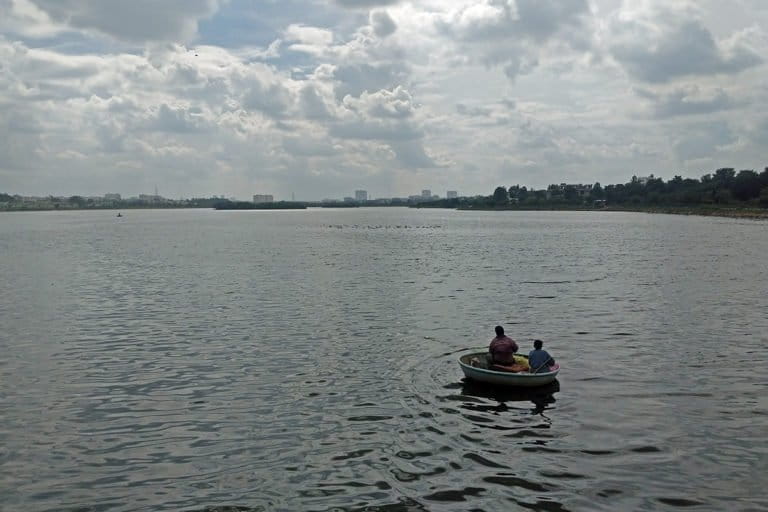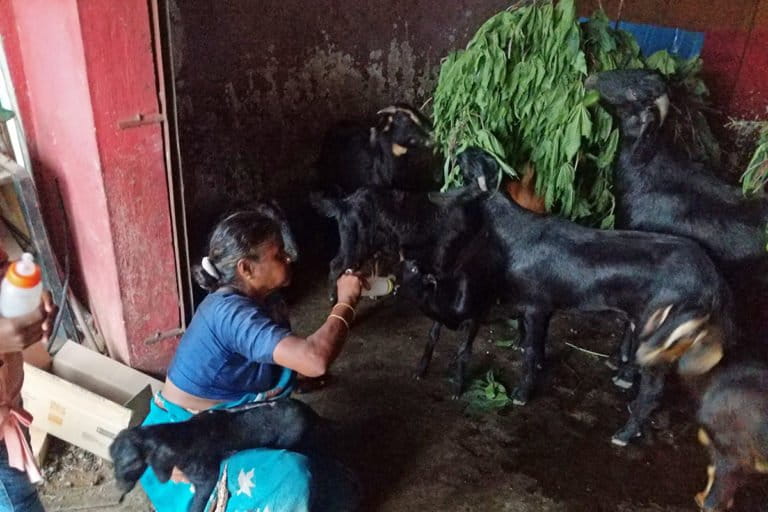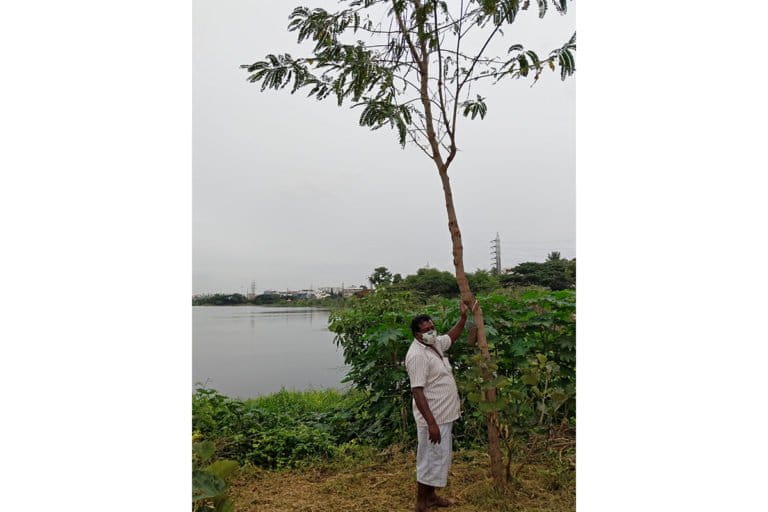- Bengaluru’s trees, parks, lakes and open spaces once offered livelihood benefits. However, the city’s dramatic growth has dealt a blow to these livelihoods.
- Putrid sewage that once filled up the 440-acre Varthur lake was recently drained, and the daily inflow of over 240 million litres of the city’s sewage has been diverted.
- The lake bed now hosts a small reservoir of freshwater collected during the recent monsoons and a vast expanse of grasses and greens which the local community harvests for consumption and sale.
- Encouraging livelihood along water bodies helps in biodiversity protection too.
It had been over 25 years since Neelamma N. Reddy went scouring for greens in Varthur lake. The lake then was a veritable buffet of greens and fish for her. She’d find over 30 varieties of fish and small crabs that could be scooped up from the lake banks. “Then, there were 4-5 types of greens we’d pick up. Some herbs, like Bassale soppu (Malabar spinach) were used to treat constipation or piles. The banks had guava, coconut and jamun trees from which children used to collect fruits,” she says.
Bengaluru’s growth turned Varthur into a part of the city’s Information Technology corridor, while the lake, much like the upstream Bellandur lake, became the largest cesspool for sewage collection. “The fish died, then the soppus either wilted away or were too polluted to be eaten,” she says.
Putrid sewage that once filled up the 440-acre lake was recently drained, and the daily inflow of over 240 million litres of the city’s sewage has been diverted. Instead, the lake bed now hosts a small reservoir of freshwater collected during the recent monsoons and a vast expanse of grasses and greens.
With sewage diverted from the lake, Reddy has once again started foraging. Her keen sight notices the juiciest of the greens and can spot the minor differences that separate the edible and the inedible. Her eventual haul includes 4 kg of Hongane Soppu (Alternanthera sessilis), chilakiruve (spinach) and Danttina soppu (Amaranthus tricolour) which are then fried and boiled into sambars and palyas. It’s a trip down memory lane for her. “I used to do this so often. Varthur was just a village and everyone would live off the lake. The poor would harvest the greens and sell it in the market,” she says.
Like Reddy, scores of people forage in the Varthur and Bellandur lakes for greens. Some keep their collection for consumption, others sell it in the market where a kilogram of greens can fetch upwards of Rs. 100.

Livelihoods lost with pollution, land conversion
Bengaluru’s loss of green spaces and water bodies has been the subject of reams of research and hours of debate. The loss of livelihoods associated with the city’s once-thriving biodiversity, however, seems confined to margins of memory.
The city’s trees, parks, lakes and open spaces, after all, do not just have aesthetic or recreational values but also once offered livelihood benefits. This can be indirect, such as providing shelter and shade to the street vendor or a lucrative point of sale in avenues that see large pedestrian footfall. Or, it can be a more direct benefit of supplementing incomes through the sale of seeds, grasses, beehives, and fruits.
However, Bengaluru’s dramatic growth has dealt a blow to these livelihoods. Villages replete with soapnuts, honge (Pongamia pinnata), neem, tamarind, drumstick, jackfruit trees – all of which had economic use for villagers and gram panchayats – were converted into residential layouts and commercial complexes. Green spaces remained confined to parks which prioritised aesthetics through planting a less diverse set of exotic trees.
Bengaluru’s treatment of lakes has accelerated this decline. Sewage inflow has seen fish stocks disappear and pollutants coat greens and fodder.


For whom are lakes rejuvenated?
In numerous lakes, rejuvenation has been for recreational value, with the lake bed scooped out in a soup bowl-design. This design results in steep banks and a uniformly-deep lake. Wetlands that tend to form in shallow waters would not have space in the lake; and this affects the biodiversity of lakes, avian fauna and reduces the space for greens and fodder. The design curtails cattle herders’ access to wetlands too.
These brute-force changes are stark in Kalkere where a 105-acre water body was rejuvenated in 2018 at the cost of over Rs. 22 crore. The lake bed has been desilted, but the wetlands have disappeared. The banks are a steep incline of manicured lawns. A nearly 5-km walking track, children’s park and a robust fence mark this rejuvenation effort.
“But, we can’t even go to the lake to graze our livestock. This was a tradition we had been following for generations. Now, we have to go 5-6 kilometers to get fodder,” says Venkatamma, who owns some 20 goats that sustains her household. Even up till five years ago, she would scour the banks for weeds and herbs.
She says, “I didn’t have to buy greens in the market. Before clinics were opened, we’d find herbs to treat wounds and ulcers. We thought that when they rejuvenate the lake, we would have cleaner water and the lake would return to its normal state. We did not think that we would be cut off from the lake.”

Instead of honge and tamarind trees, the Kalkere lake banks sport a variety of exotic species including palm trees. This preference for narrow, fast-growing trees is apparent in the saplings planted by the newly-widened roads, in an area that is fast becoming a suburb of low-rise apartments, gated communities and small industries.
Around the severely-polluted, frothing Margondanahalli (or Huvinane) lake too, honge and tamarind trees have disappeared. H. Manjunath, a cattle herder whose house abuts the lake, says, “The village used to have so many honge trees. As children, we used to be sent out twice a week to collect honge seeds. This would be dried and given to the travelling salesmen who would convert it to oil. The poorer people from the village used to earn a living out of it and from the tamarind trees. But, few trees are found now.”
Honge seeds are being sold at Rs. 190 per kg at Hoskote, making it lucrative if one can find trees. “We still collect honge seeds before Ugadi – it feels like tradition and it is good money to buy new clothes,” says Manjunath.

Ways to ensure livelihoods
Kalkere’s experience is not far off from the sweep of gentrification that is pushing pastorial practices out of the city. Bengaluru’s afforestation and tree planting schemes do not seem to believe livelihood is a priority.
Seema Mundoli, a senior lecturer at Azim Premji University (APU) who has researched urban commons in Bengaluru, says, “There is a perception among urban planners that if you plant fruiting trees or economically useful trees, then people will fight over access. Who has the right to collect the seeds and fruits, may become tricky. But, there are community-based solutions to these questions.”
For instance, Delhi has been managing the harvesting of jamun trees through tenders for collections and sales. Mundoli says, “This is a traditional practice; people camp under trees to protect their jamun harvest. In Bengaluru, we could look at ward-level communities for the management of these commons – income generation through the sale of seeds and fruits or, collection of greens and reeds from lakes.”
Harini Nagendra, also from APU and a prolific author and researcher of biodiversity in the city, notes urban incomes can be supplemented if biodiversity is conserved from a livelihood lens rather than just an aesthetic lens.
She says, “In the markets of Banashankari, you find tens of varieties of soppus, medicinal plants and herbs foraged from spaces around Bengaluru. Women or people who are out of jobs forage to supplement income. Encouraging these livelihoods becomes about sustainability, food security and reducing carbon footprint for the city. It is also about protecting traditional knowledge.”
Livelihood protection means biodiversity protection too
These livelihoods in turn play an important role in conserving biodiversity. Jakkur and Kaikondrahalli lakes’ community-centric lake rejuvenation models showcase this success. Here, cowherds, grazers, farmers and fishermen were involved with rejuvenation, ensuring the close-knit relationship between society and the lake continues.
Nagendra says, “These lakes get treated water from sewage treatment plants. But, it still has high nitrogen and phosphorus content that is absorbed in the wetlands. You’d need to remove the grass from the wetland regularly to encourage plant growth. Grazing then becomes an important biodiversity service.”
‘Meen’ Yellappa and his group of 50 fishermen, who have won fishing rights over the newly-rejuvenated Agara Lake, have been using their traditional knowledge to help civic bodies make the lake more hospitable not just for walkers, but for foragers, cattle herders, and flora and fauna.
“If left to the city corporation, they’d keep clearing weeds entirely from the lake. We had to tell them to leave some in the borders and in the corners of the lake. This is crucial for birds to lay their eggs, for insects on which fish and birds feed, and for fish themselves,” he says.
People like Yellappa do more than just survive on the lake. They ensure it thrives. They keep their eyes out not just for fish to catch, but also for catfish. “Catfish can eat up to 2 kg of local fish a day. It can destroy entire ecosystems,” he says. The group expects to catch over 50 tonnes of fish over the next three years, including rohu, catla, common carp, mirgal and jalebi.
Their experience is also indicative of why economic benefit from lakes should be distributed among locals primarily rather than outsourced to fishing firms. The fishermen clear aquatic weeds – using some for manure, and some as fodder for the over 10 cattle herders that depend on them.

Four varieties of greens grown on the banks of the lake and garke (Cynodon dactylon which is used for religious rituals and ayurvedic practices) are harvested by around five low-income households. Honge trees by the banks are harvested for seeds before Ugadi, and Yellappa estimates each fisherman earns around Rs 3,000 through this. “Through all this, we don’t really need to extract fish through the year. We take a break during the monsoons so that the fish population can recuperate,” he says.
Furthermore, the fishermen, who were befuddled by the planting of palm trees and other exotic species, have planted agse (Sesbania grandiflora or Hummingbird tree), Indian fig tree and Jamaican cherry tree (gasagase in Kannada) whose fruits can be consumed. “At the least, anyone hungry in the park will find something to eat,” says Yellappa.
Read more: Katte and Kunte: The lesser known water bodies of Bengaluru
Can Varthur lake revival save livelihoods?
There is a frenetic activity in the wetlands of Varthur lake, which is at the start of a long road towards a National Green Tribunal-monitored rejuvenation. Bikes, autorickshaws, small goods vehicles make their way towards swathes of 10-foot-high grasses that cover the emptied out lake bed.
For nearly a decade now, 22-year-old Ravi, a college drop-out, has relied on Varthur’s grass to feed his six heads of cattle. Each day, he makes a trip on his two-stroke bike, carrying nearly 200 kg of fodder in four trips.
“Traditional grazing spots have been reducing, and more and more farmers have been coming to the lake to take fodder. But this lake is so big that it can cater to us all,” he says.
There is an initial tremor of excitement at the imagination of the lake filling up with clean water and the stench of sewage reducing. But, there is a concern. “I hope that they (civic authorities) leave at least 100-150 acres as wetlands for us. If they don’t do this, I will have to sell my cows,” Ravi says.
The civic organisation Varthur Rising’s Jagadish Reddy, who is keenly following rejuvenation efforts, says they will ensure that access to the lake is not compromised during rejuvenation. After all, the lake is a key part of Varthur village’s economy.
Reddy of Varthur Rising says, “This lake is important for cattle herders and farmers up to 5 km away. It can’t just be for recreational purposes. It is an important part of local livelihood and local memory. We can’t lose it.”
This article is part of a series on Bengaluru’s Ecosystems and Biodiversity, a joint project between Mongabay-India and Citizen Matters, supported by the Bengaluru Sustainability Forum (BSF).
Banner image: 22-year-old Ravi, a college drop-out, relies on Varthur lake’s grass to feed his cattle. If the wetland disappears, he worries that the cows will have to be sold. Photo by Mohit M. Rao.
